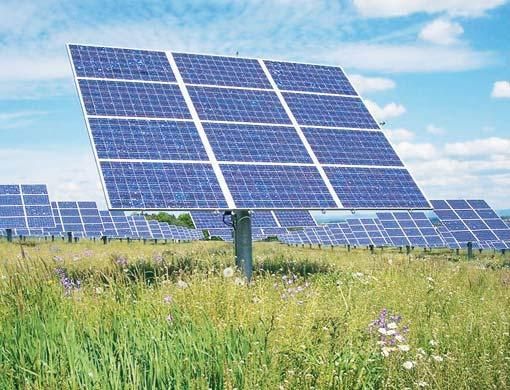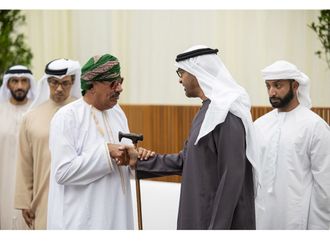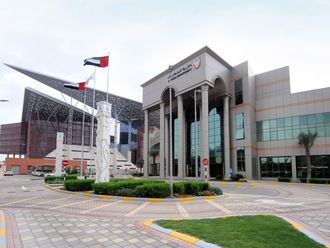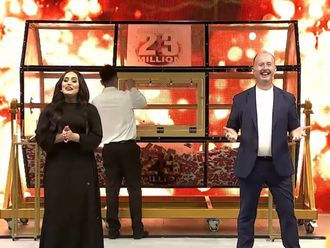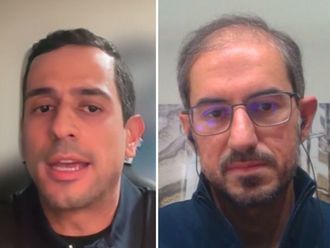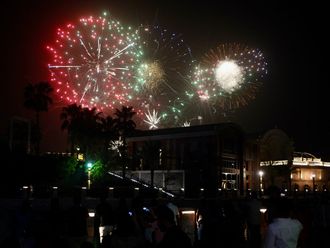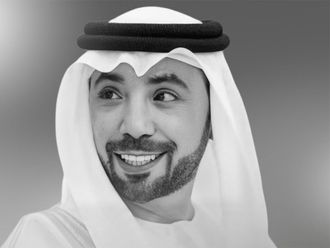The UAE is finally making the most of its sun-drenched habitat. Perhaps being slow off the mark, the country is speeding ahead to develop avant-garde technology to feed a growing solar industry which, in just over a decade, will attract $20 billion (Dh73.4 billion) in investments and will avoid the emission of 362 million tonnes of carbon into the atmosphere.
The following report highlights some of the latest solar power devices making their debut in the UAE.
Floating islands: With a thermal energy reservoir, they will provide energy round the clock
Cutting edge solar technology coming out of Ras Al Khaimah is set to push the UAE even further down its path to a solar revolution, and give beachgoers something to ponder.
Giant discs covered in solar panels and launched at sea to capture the sun's rays and create electricity and hydrogen could be visible on the UAE's coastline in a number of years.
A prototype of a floating solar island is currently being developed at the headquarters of the Swiss centre of electronic and micro technology (CSEM or Centre Suisse d'Electronique et de Microtechnique) in Ras Al Khaimah.
Funded by the government of RAK, the $5 million (Dh18.35 million) project equipped with thermal solar panels will first be tried and tested in the desert before being launched at sea.
"Our objective with this project is to answer a growing need for energy, not just renewable energy but energy in general," said a spokesperson from CSEM – UAE. "The prototype will be tested in the RAK desert. We need energy as our current consumption is constantly being underestimated," he said. "All the solar panels are being created here as well which will allow us to develop a solar energy industry linked to our solar expansion."
The energy generated from the solar island could feed a thermal plant, be used to power a desalination plant or both at the same time, a process called cogeneration, yet the definitive use for the energy has not been defined.
The prototype, due to be operational by the end of 2008, will measure 100 metres in diameter. The actual solar island which has already generated interest from neighbouring Bahrain, will measure 5 kilometres in length and be 20 metres high.
The whole platform will adjust its position to the course of the sun to guarantee a maximum yield rate. To enable the platform to move, electric hydrodynamic motors will be fixed every 10 metres along the circumference.
The platform can float on high seas, on remote coastlines and even be positioned on land. The concept comes from CSEM and is being sponsored and co-developed by Ras Al Khaimah Investment Authority (RAKIA).
The prototype will contain, among other things, a thermal energy reservoir and will provide an energy supply 24 hours a day, irrespective of time of day or night. The target costs of the prototype system are estimated at less than $100 per sq metre. The peak power will amount to approximately 1 mega watt, with an average power of 250 kilowatt, while annual energy production is expected to reach 2.2 gigawatt-hours.
Crossing the creek: Authority aims to reduce pollution and fuel costs
A solar-powered way of crossing Dubai Creek was announced earlier this year by the Roads and Transport Authority (RTA) who are working towards introducing abras (water taxis) powered by the sun.
As well as attracting more people to use public transport the environment-friendly passenger vessels will reduce pollution and fuel costs.
A pilot project launched in August saw two abras converted to run on solar energy and compressed natural gas (CNG).
Abras are the cheapest mode of transport in Dubai with a Dh1 fare for a one-way trip. Around 25 million passengers used the abra service last year, Gulf News reported at the time. Initially three abras were converted from diesel to CNG but the project failed as the boats were too slow. Now with two of the 149 abras planned to run solar energy and CNG, hopes are high.
Companies have been approached to develop a solar powered engine and offers are being assessed.
Parking meters and street lights: Best for places where providing mains supply is costly
Parking meters and now street lights are getting the solar treatment in Dubai.
Motorists have been able to pay for parking from solar powered parking meters dotted around the city for nine years already.
Recently two solar powered street lights were also erected in Dubai to promote an environmentally friendly lifestyle.
The Energy and Environment Park (ENPARK), a member of Tecom Investments is behind the sustainable lighting solution.
Two lampposts with solar panels situated above the bulb will store energy from the sun throughout the day and automatically turn on at dusk and switch off again at dawn.
The initiative is in partnership with Green Energy Solar (gesolar), a solar products and solutions provider.
Powering street lights with the sun means that they can be positioned anywhere and specifically in places where providing a mains supply is expensive.
The solar panel is guaranteed for 20 years and can reduce labour costs and increase street safety.
Keeping cool at bus stops: Solar-powered shelters coming soon in Abu Dhabi
Commuters will be able to surf the internet or withdraw cash, or even stay cool while having a cup of coffee at one of the capital's soon to be unveiled solar-powered air-conditioned bus stops.
The first prototype shelter of its kind has been put up in Abu Dhabi on Airport Road behind Shaikh Zayed Mosque by the Abu Dhabi Public Transport Department.
The bus shelter has been installed for demonstrative and experimental purposes said an official source at Abu Dhabi Public Transport Department.
"Discussions on the project are in the primary stage. Numerous companies have come forward to bid for the project to install the solar powered shelters all over the emirate," the source said.
Facilities
The shelters will be powered by solar panels so major road excavations to install costly power supply cables will not be necessary.
Running costs will be minimal and the reliability of the unit means there is little need for maintenance.
The public can enjoy facilities such as cash withdrawal machines, access to the internet, coffee and soft drinks vending machines and public telephones inside the shelters.
This initiative is fitting to Abu Dhabi's goal of developing real solar powered solutions for everyday living.
Masdar, the region's first alternative energy and resource conservation initiative launched by the Abu Dhabi government in April 2006 has bought advanced solar technology to the city.
A complete city that will be home to some 47,000 people, powered by the sun is being built by Masdar, which means the source in Arabic. The city will be a zero-carbon, zero-waste zone and is planned to open in late 2009.
Projects already in active development include both photovoltaics (PV) and concentrating solar power (CSP). Plans are in the pipeline to make use of solar energy for household and industrial purposes.
Masdar's PV projects include a world-scale polysilicon factory.
"CSP offers considerable potential for Abu Dhabi to become a leader in clean renewable energy, due to the extensive local sunshine conditions as well as the maturity of the technology, " said Masdar's CEO Sultan Al Jaber in a statement which was released earlier this year.
- Binsal Abdul Kader and Rayeesa Absal, Staff Reporters
Homes and housing: They also tap into wind energy when sun sets
After solar street lights and solar parking meters come solar powered houses. The concept which hails from Sweden has already been tried and tested in Saudi Arabia and Bahrain and manufacturers are ready to develop the idea in the UAE.
Representatives from Scandinavian company Switchpower presented the scheme of developing large residential housing areas that use a fraction of energy from the local power network to authorities here earlier this year.
The houses focus on insulation and have triple glazed windows. Air conditioning systems all run on solar power. According to the proposal the houses have been designed to create shadow areas throughout the day with an insulated south-facing wall, whilst the angle of the roof is calculated to achieve maximum performance from the solar power panels placed on its surface.
Currently there are no solar powered houses in the Middle East but Bahrain is apparently quite interested in the project.
"These houses can then be combined with wind power to continue providing power when the sun has set," said a Switchpower representative. The cost of a house fully equipped with solar cells has not yet been outlined however.
What is solar energy?
- Capturing and converting the sun's energy to produce electricity and heat
- Solar power uses photovoltaic cells to convert sunlight directly into electricity by converting photons (light particles) into electrons (negatively charged particles)
- Photovoltaic (PV) cells are made of special materials called semiconductors
- Silicon, mixed with other atoms, is currently the most commonly available semi-conductive material
- When light strikes the PV cell, a certain portion of it is absorbed within the semiconductor material, meaning that the energy of the absorbed light is transferred to the semiconductor. The energy knocks electrons loose, allowing them to flow freely.
- PV cells force electrons flow in a certain direction, called a current.
- This current, together with the cell's voltage (which is a result of its built-in electric field or fields), defines the power (or wattage) that the solar cell can produce.
Your comments
Solar energy should have been implemented by now in the UAE. All the free areas in the desert can be used to set up solar panels and lots of energy can be derived from it.
Mohib
Reading,UK
Posted: October 01, 2007, 15:02
The UAE's potential for generating power from solar sources is massive. Someone has to take the initiative. Towers can install building integrated PV panels to generate enough power for itself and transmit excess energy to the national grid as many European countries do. Public awareness is low.
Johnson
Dubai,UAE
Posted: October 01, 2007, 12:01
It is about time! I just could not underestand why UAE was not tapping into its solar abundance. Where as countries with a fraction of solar exposure to UAE are still making full use of it. UAE must also consider dual fuel cars.
Mohamed
Melbourne,Australia
Posted: October 01, 2007, 04:24


